-
Versatile tech with a full range of product and tools.
-
Strong team with relevant backgrounds.
-
Working products and services.
- Well established core Waves protocol that capitalized on ecosystem growth.

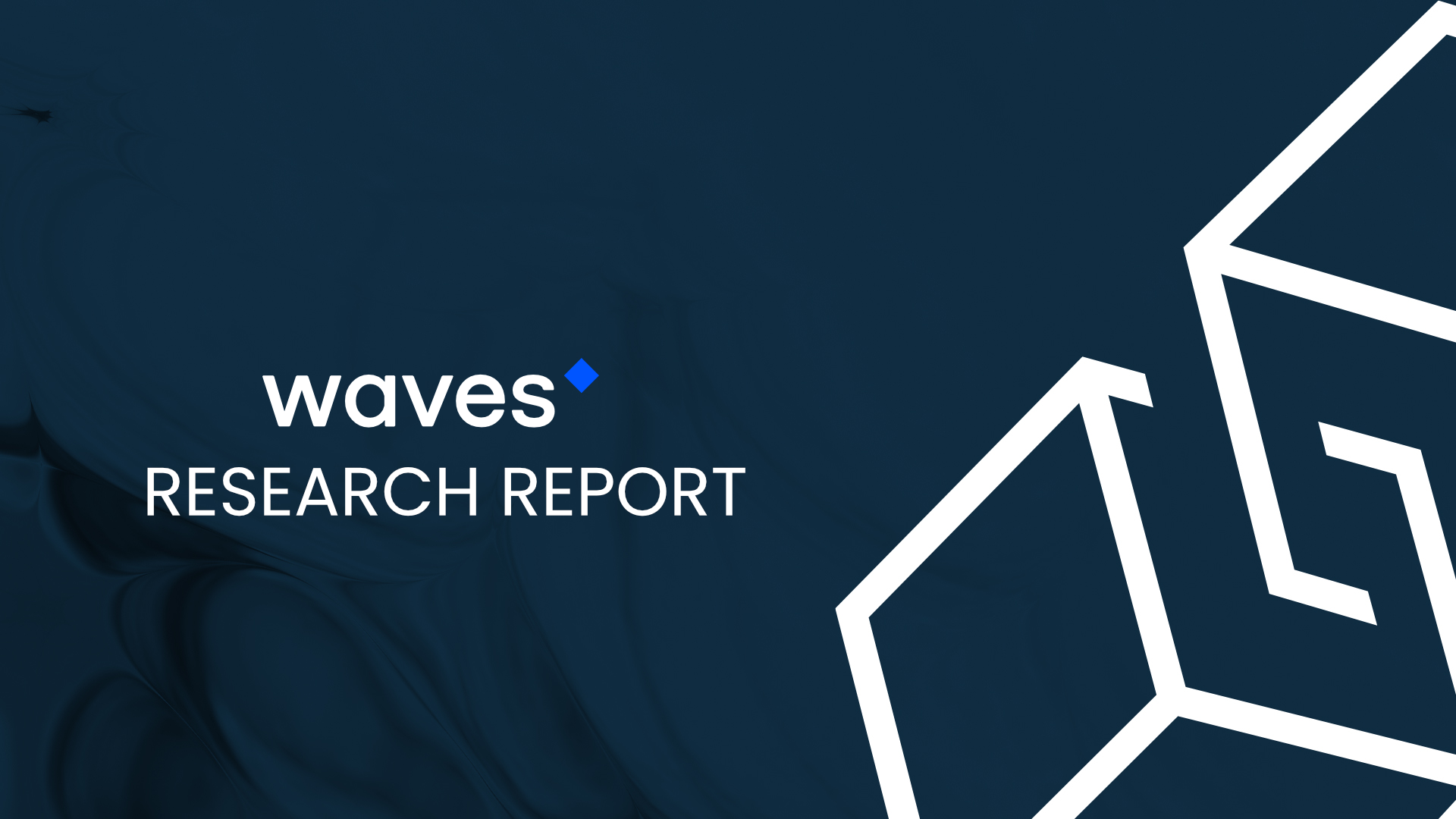

Lower ranks are better

Versatile and all encompassing tech
Dedicated founder with proven track record in his field of expertise
The project has been in the market for around 4.5 years and is still ranked on the first page of the CoinMarketCap
Versatile tech with a full range of product and tools.
Strong team with relevant backgrounds.
Working products and services.
No clearly defined roadmap
Not being able to articulate the main competitive advantage and is too technical.
With its new set of protocols it can enter the DeFi space and take the market share from newly found projects.
Ease of use and DeFi toolkits may draw in a new set of developers wanting to push innovation.
USDN can be brought forth as the new stablecoin in demand.
Waves adopts well to market cycles, but many pivots could reduce focus.
Their Lack of a loyal user community is strong but stagnating. Lack of growth may bring this platform down to being merely a technology tool that hasn’t much use.
Team members are too fluid and are frequently switching and leaving which may lead to prolongations in implementing new ideas.
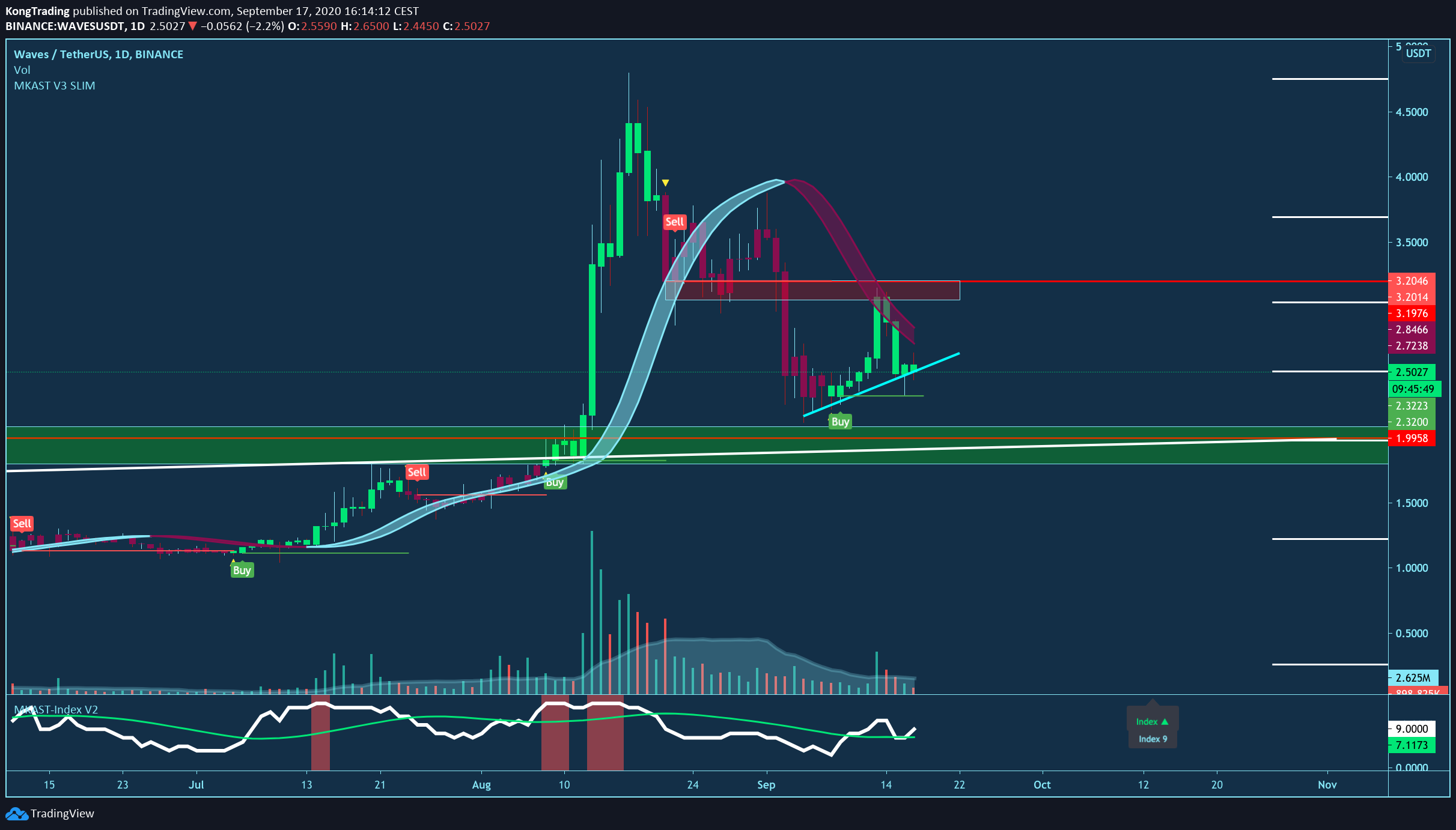
Technical Analysis by Kong Trading - 17/09/2020
WAVES has been making solid moves and strong impulsive moves, have decent retraces attached to them. This is exactly what we are seeing here on WAVES today.
First, a powerful breakout, followed by a retrace and S/R flip of the breakout area, then another "test-pump," which brings us to the levels we see.
To read the full Technical Analysis from Kong Trading click here.
Waves tagline is “Innovations of tomorrow for people of today”. They go on to say: “ .. advancing technological frontiers for the pioneering developers of tomorrow and adopting them for every-day practical implementation.
The name Waves refers to the account driven open blockchain platform for exchanging value over the internet in a decentralized way and its SDK tools (Software development kit) for developing Web 3.0 applications. It uses its native WAVES token to perform transactions that are different for token transfer transactions and data transactions. Like Ethereum, it has smart contracts, a programming language called Ride, the possibility of creating custom tokens (smart assets), and decentralized applications.
It's governed towards ease of use for the end-user to utilize blockchain's power by increasing simplicity and feasibility in development or plain participation, thus reducing entry barriers and lowering onboarding friction on to the blockchain.
It's governed towards ease of use for the end-user to utilize blockchain's power by increasing simplicity and feasibility in development or plain participation, thus reducing entry barriers and lowering onboarding friction on to the blockchain.
It uses leased proof of stake consensus mechanism (LPoS), allowing users to lease their tokens to a Waves node, which validates transactions, earning a percentage of the node payout as a reward. The more tokens the leaser stakes, the higher the chance for that node is to find the block, thus the higher chance of getting the reward. A minimum of 1000 WAVES tokens is needed to run a node while there isn't a minimum for leasing to the node.
Interoperability is yet another feature of this blockchain managed through the Gravity protocol solving the problem of fragmented data throughout the cryptocurrency market and real-world databases. Gravity is a blockchain-agnostic oracle and serves as a cross-chain communication network in a fully trustless decentralized way. Unlike other blockchain-based oracles, it runs without a token that guarantees that it doesn't favor any particular one.
A third protocol component in the Waves ecosystem is its Neutrino protocol for that enables the tokenization of real-world assets such as USD into USDN whos price stability is ensured by Algorithmic stability and The Neutrino system base token (NSBT) as a reserve currency locked in the smart contract. This is mainly governed by enabling DeFi and creating a stablecoin USDN, which can be staked for a sustainable yield of 12-15% APR.
Waves platform also has its decentralized exchange (DEX) on which you can trade and invest in traditional cryptos as well as created custom tokens and smart assets.
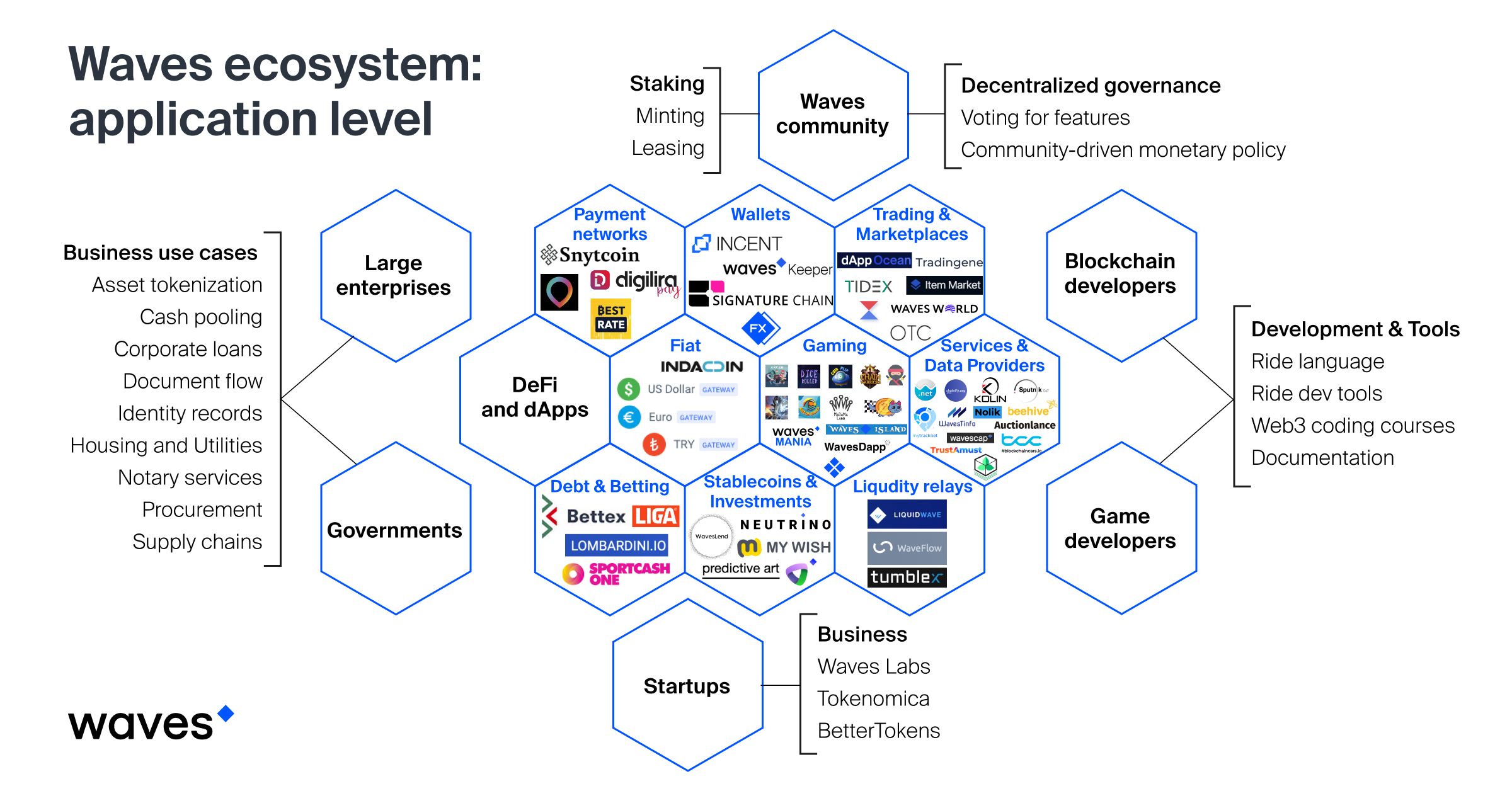
Waves platform has three protocols: Waves, Gravity, and Neutrino, while its ecosystem consists of a decentralized exchange, decentralized applications and smart contract programming language, and native WAVES token.
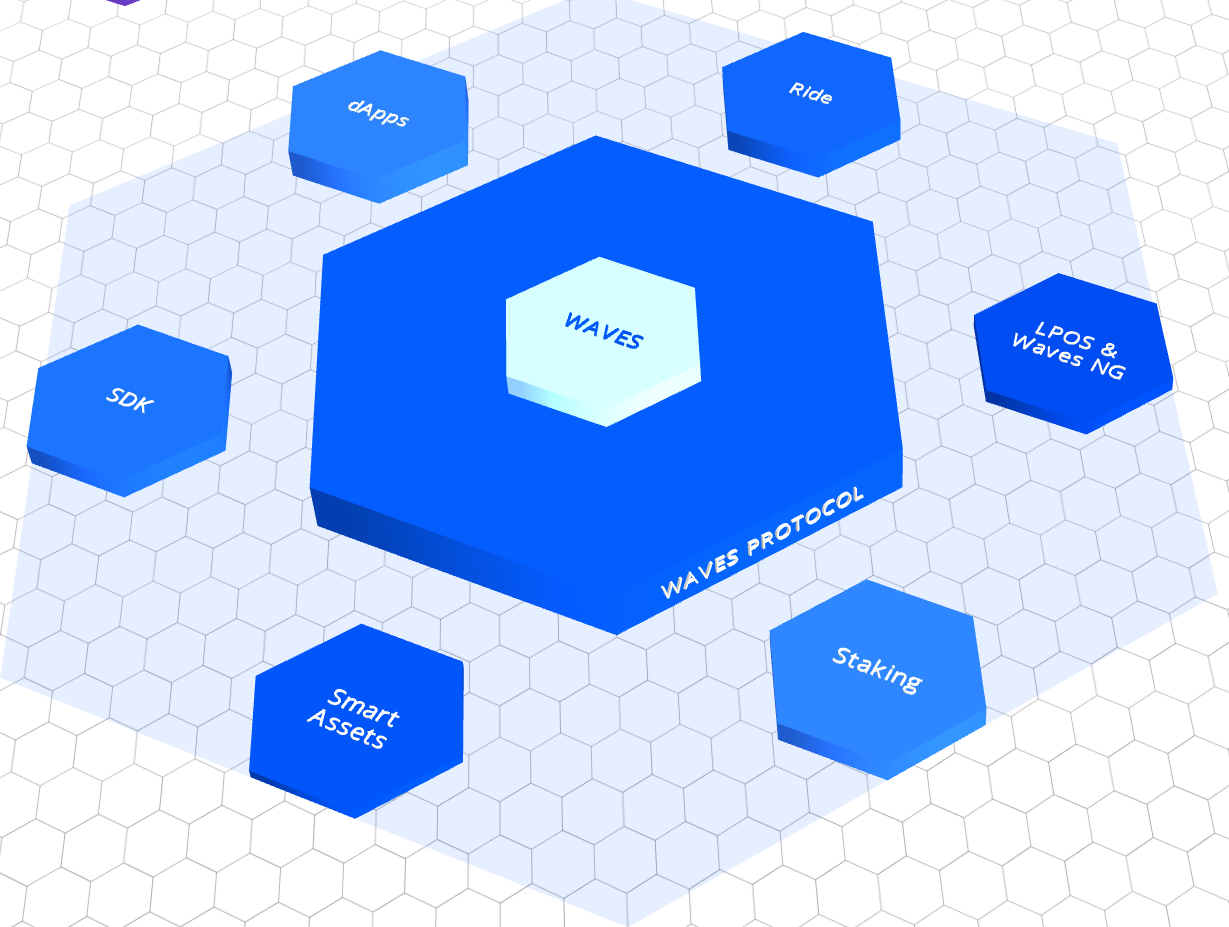
Wave protocol is the main blockchain with its native WAVES token and is the platform referred to as the place that hosts decentralized applications and smart assets.
It utilizes what was proposed but dismissed on Bitcoin for its scalability issue and implements the NG protocol for Waves-NG. It increases the blockchain's performance by using "liquid" blocks. Unlike traditional that are fixed in size, these liquid ones continuously grow until the next block is found.
First, a leader block is chosen by the proof of stake mining mechanism. It doesn't contain transaction data but only serves a purpose as a numerator. These are also referred to as key blocks. When the key block is set, a set of micro blocks have created that consist of ledger entries but are entered by a delegated node (elected leader), and proof of stake isn't used.
The network is made to adjust its throughput and reach its highest, depending on the network conditions. With this solution in place, the blockchain can handle 100 Tx/second and usually takes about 2 seconds to add a transaction to the block, contributing to the user experience.
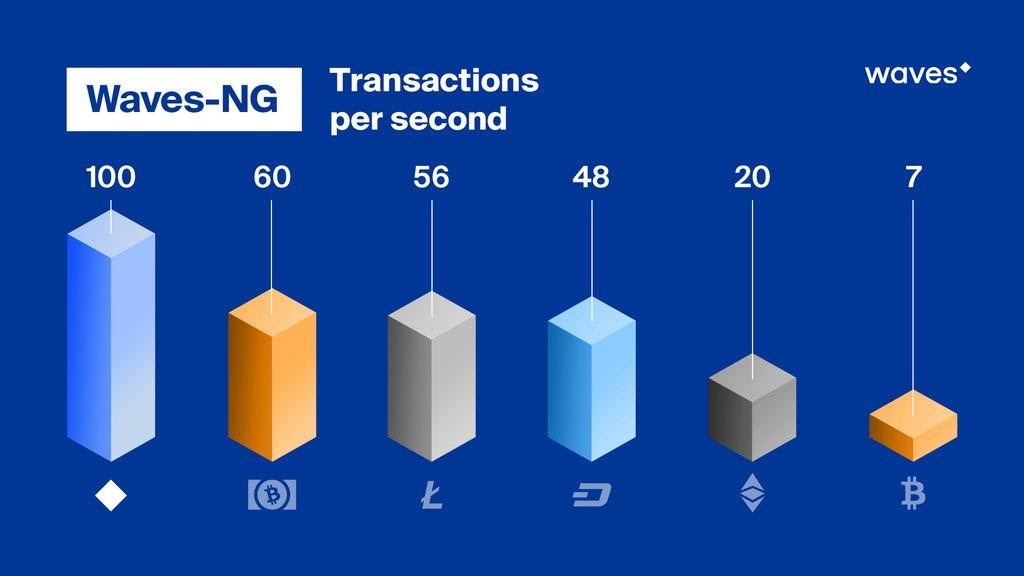
To run a node, one must stake at least 1000 WAVES tokens as the protocol runs on a proof of stake consensus mechanism. The node that participates in validating transactions gets rewards in the WAVES token, and the more staked into the node, the more rewards are received. To increase the reward amount or get rewards without running a full node, a user can lease tokens to the node; thus, this is called a Leased Proof of Stake (LPoS).
Reward size is changed by voting from the nodes and is done every 100,000 blocks (around 70 days) for 10,000 blocks. In this time window, the miners can vote to decrease, increase, or keep the current reward size, and when consensus is reached, it stays immutable for another 1000,000 blocks.
Interaction with the blockchain is account-based. All assets and data are associated with the account, which has a pair of keys: a private key that the account uses to sign transactions, and a public key that allows anyone to verify the signature.
In Waves, all blockchain data such as token issues, cryptocurrency transfer, smart contract creation, or invocation are presented as transactions. Thus various transaction types vary depending on its purpose and are divided into three categories: tokenization, usage, network.

Smart contracts and decentralized applications are built using a proprietary programming language called Ride. Based on expressions, it is case-sensitive and has no loops, recursions, and go to-like expressions, and is therefore not Turing complete. Designed in this way, it is fault-proof and aims to minimize the room for making common errors and critical mistakes when developing on the Waves blockchain. The creation and deployment of smart contracts and other scripts don’t require gas, and its developer-friendly infrastructure helps facilitate experimentation and innovation.
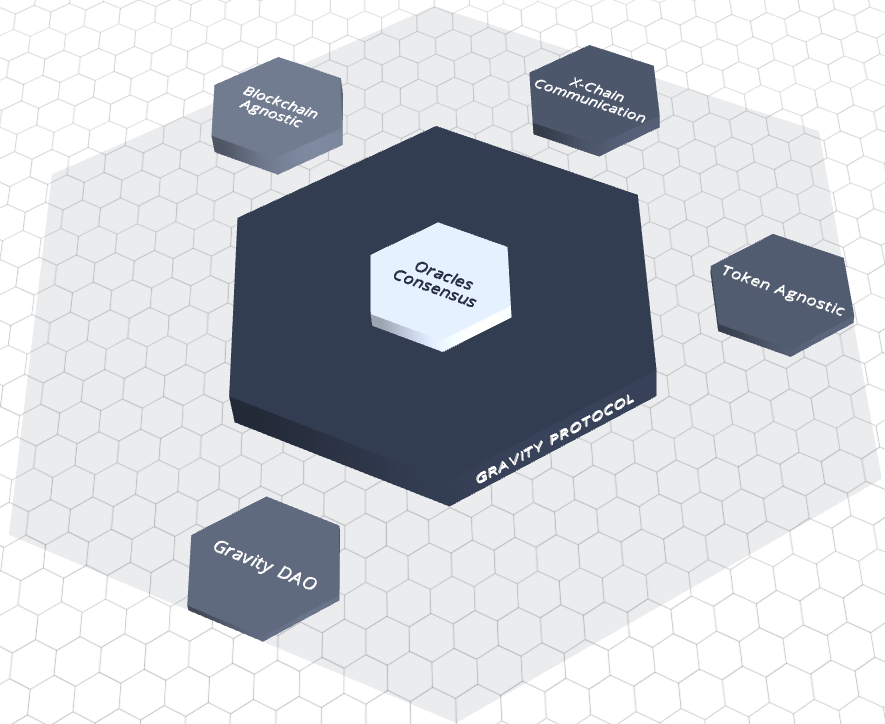
Gravity is an oracle layer for Waves blockchain to make possible cross-chain interaction and bring real-word data on the blockchain in a decentralized and trustless way. This is achieved by building a network of nodes that validated external data by reaching consensus instead of relying on a single source of information.
To build a protocol that reaches consensus, it requires an economic incentive to its participants to perform such tasks, but that comes with the conflict of interest as the new layer will favor its network over other data sources and be keen on providing rewards to its operators.
Gravity is built in a tokenless way to solve this problem of conflicting interest and doesn’t attempt to create new value but instead leverages the value locked in the blockchains it works with. To participate in the Gravity network and run a node, you need to lock a certain amount of the native token for the chain you are mining data on. Those who use that particular chain pay for the data provided, and the rewards are shared by all nodes based on the quality of data provided and a total input received.
This is what is meant by being blockchain agnostic. The network doesn’t rely on its token to keep incentivizing its participants to provide reliable data. Instead, it behaves like a PoW network where miners (Gravity nodes) provide data in exchange for existing cryptocurrencies of the chains they work on.
In addition to providing data, cross-chain providers can provide liquidity of existing coins and assets for the execution of cross-chain swaps, which is a perfect solution for decentralized financial applications that have to fetch data on price, quantity, etc. from various blockchains in a trustless way and building decentralized exchanges which Waves already has.
Promising frictionless DeFi integration by acting as an interchain toolkit for multi-assetization is the Neutrino protocol. It can perform tokenization of real-world assets like national currencies, commodities, etc. by maintaining price stability through an algorithm and its native token, Neutrino system base token (NSBT), which is held in reserves and a network of oracles (like the Gravity protocol).
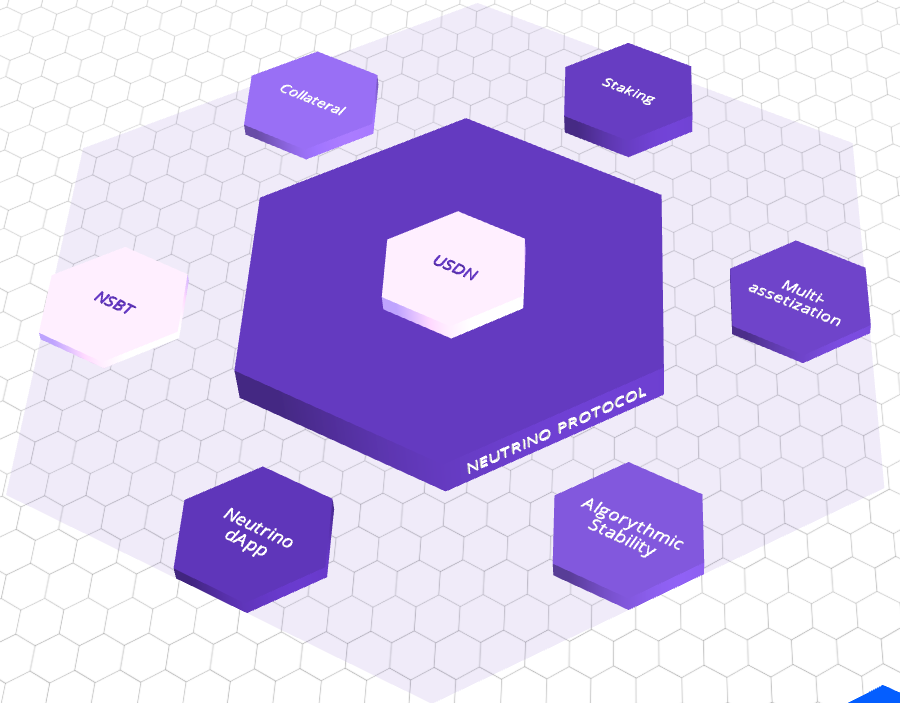
The goal is to create a price equilibrium between the capitalization of a tokenized synthetic asset (for example, the dollar’s neutrino) and the capitalization of collateral represented by a native token (such as Waves), similarly like in the case of MakerDAO DAI, whose value is maintained by algorithmic stability.
Through NSBT, an incentive is ensured that in case of diminishing reserves in the underlying asset that is tokenized, the collateral will be replenished by the purchase of NSBT or release from reserves. NSBT tokens and tokenized assets are further collateralized by WAVES native token to ensure further stability.
For example, collateralizing WAVES for the USD equivalent value to come up with a USDN stablecoin backed by WAVES is algorithmically maintained at a 1:1 peg to the USD. This is its first use case developed by the Waves platform and can be staked for an 8% to 15% annual percentage yield, depending on WAVES' market price.
Similarly to other DeFi solutions sending collateral to the smart contract and tokenN is created whose underlying value is maintained and guaranteed by the collateral or the NSBT in the last resort.
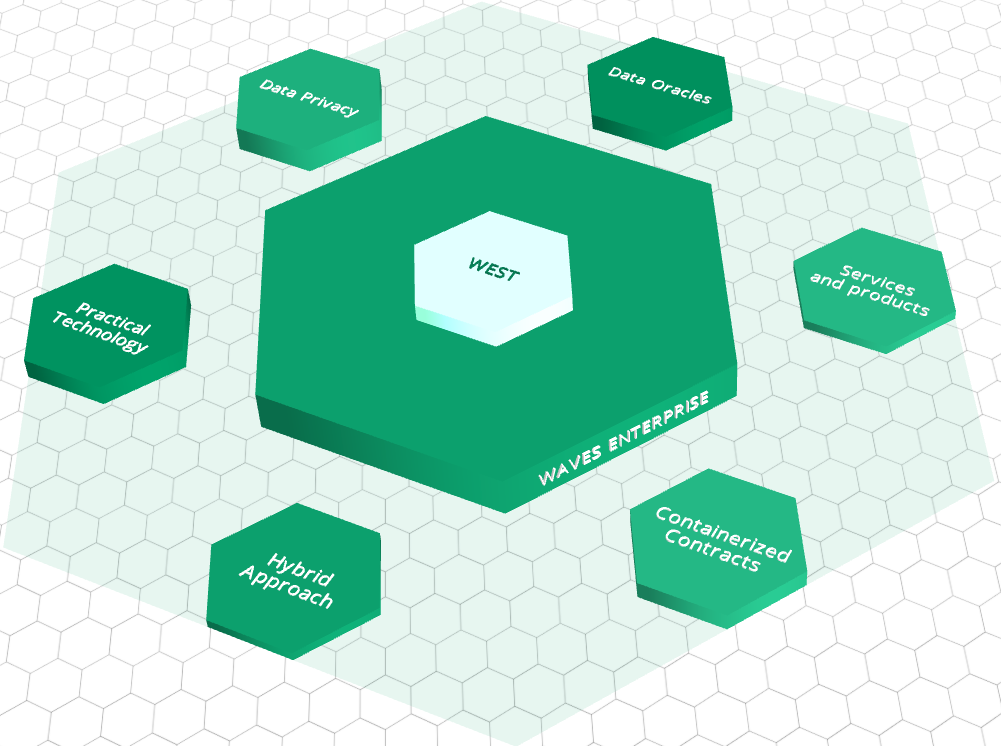
There is another hybrid blockchain called Waves Enterprise with a native token WEST and is a combination of a public and private network. Waves Enterprise brings together enterprises, service providers, and decentralized applications in a trustless environment, utilizing the benefits of public permission blockchain across a wide range of business use cases.
With features like E-voting and Facial recognition, it is perfect for large corporations that engage in d
ecision making through a voting process and track presence and work performance through check-in credentials.
Waves are for the end-user, developers, and enterprise alike as it provides a multifunctional platform with a vast set of features. Therefore the end-user can want to transact the WAVES token over the blockchain or trade and invest in different cryptos through their decentralized exchange. They can also earn rewards by utilizing some staking options like leasing to a node, running a full node to validate transactions, or staking USDN for a 12-15% annual percentage rate.
| Developers can write their decentralized applications in the Ride programming language as well as smart contracts and smart accounts and deploy them cheaply on the network without paying gas fees, which reduces the cost of production and incentivizes creativity. | |
| Enterprise can benefit from using the platform for its ease of use, interoperability, and, most notably, for creating and issuance of custom tokens and smart assets. Building a decentralized application and associate custom token has its primary use case in ICOs and crowdfunding. At the same time, collectibles are also a major one as non-fungible tokens are available as well. |
Waves ecosystem consists of three components:
Network protocols like Waves, Gravity, and Neutrino, with their own set of rules, transaction models, and consensus mechanisms, were covered in great detail in the technology section. These protocols are the ecosystem's backbone, and they introduce multifunctionality and technological base for development and usage.
The second component is the infrastructure built on top of those protocols. It consists of: Keeper for private key management, IDE for sandbox development, smart-contracts programming language RIDE, and other tools for dApp development, APIs, libraries, tools, and frameworks.
The third and most practical application layer consists of a large set of decentralized apps such as decentralized exchange (DEX), mobile apps, and mining and voting apps. Various dApps are running on the network for staking and lending its USDN token.
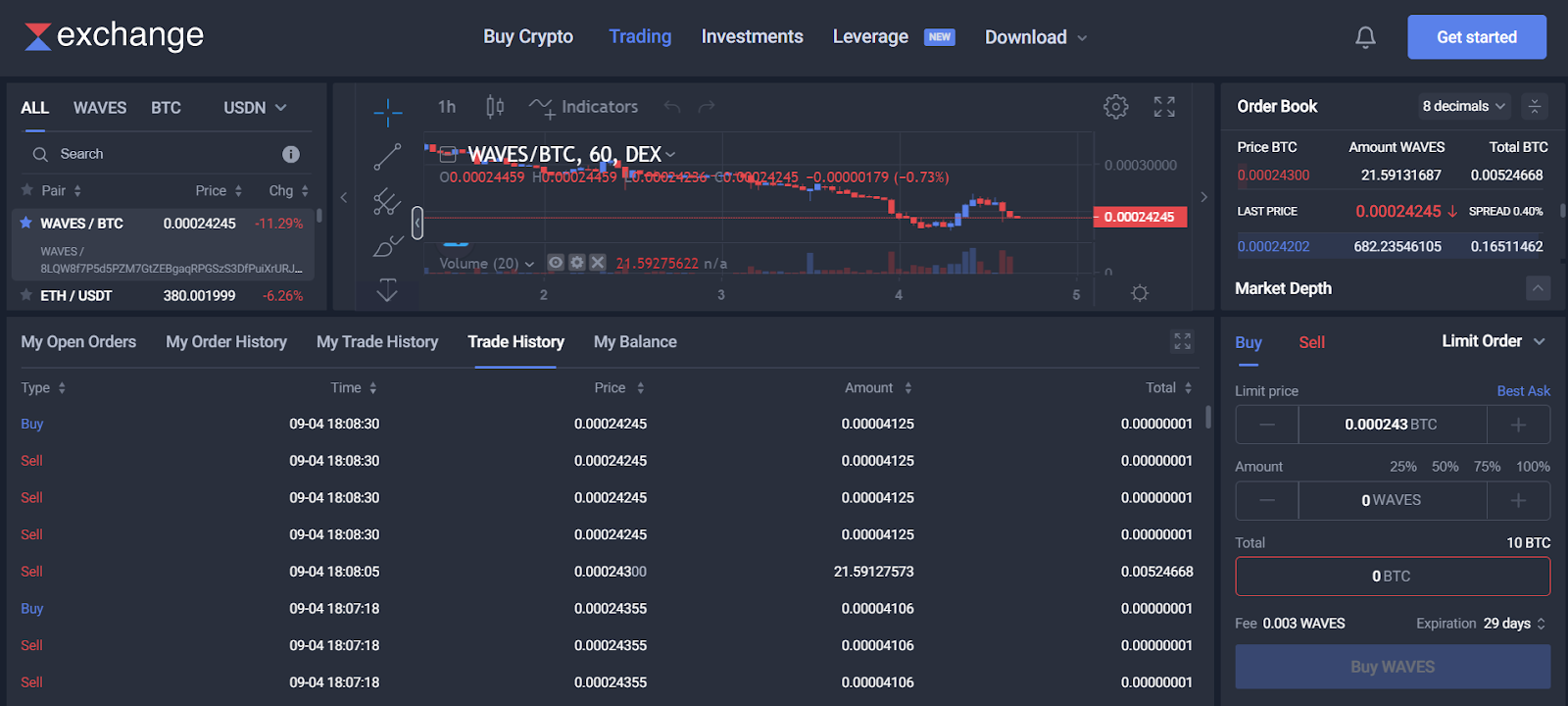
Waves platform has immense use case possibilities. As a platform that enables all the tools and necessities to build and engage in a decentralized economy, it is suitable for plain users. They want to perform transactions of value for developers wanting to build decentralized applications and for enterprises wanting to mitigate their existing infrastructure on the blockchain.
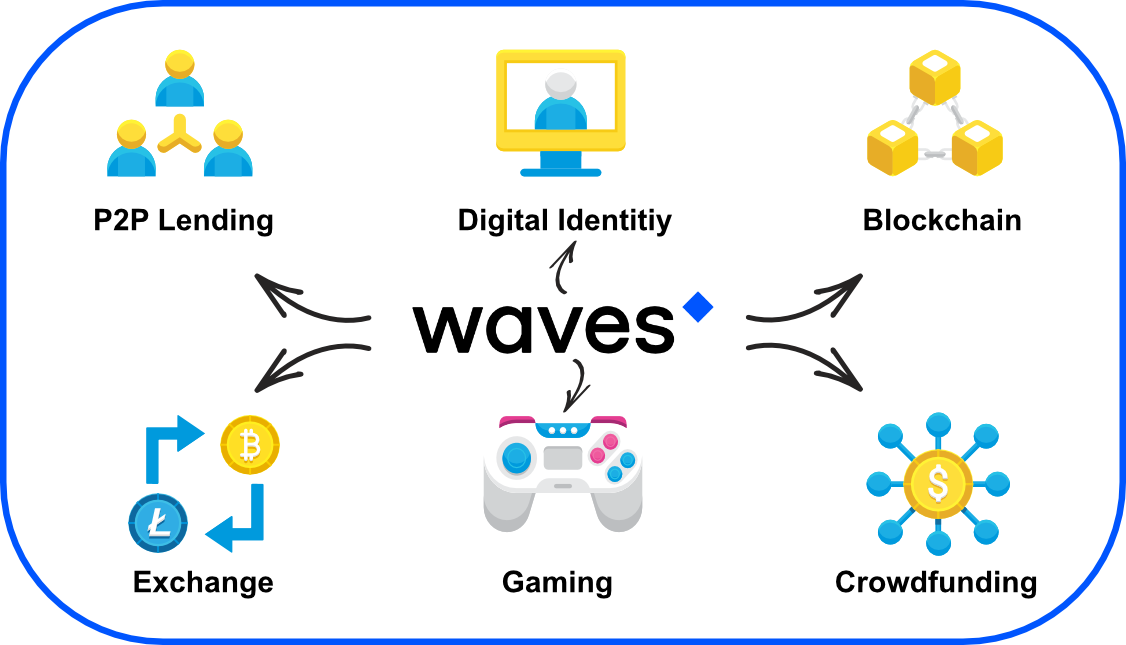
The functionalities and features of the Waves ecosystem are suitable but not limited to: decentralized finance applications (DeFi), decentralized autonomous organizations (DAO), donations and crowdfunding, escrow service, referral, and loyalty program, marketplaces, P2P lending, gaming, voting, digital identity management and much more.
Waves ecosystem is composed of all the tools needed to participate, build, and do business in the distributed economy.
Its WAVES token is used both as a native token to the blockchain for doing transactions and for staking in the nodes to validate transactions and earn it as rewards. Another essential function is being used as collateral for creating the USDN stablecoin as it is backed by a certain amount held in reserves.
As a technology platform focusing on Web 3.0 — a transparent, private, and fair ecosystem powered by decentralized technologies. Waves immediate competition are other blockchain platforms that are focusing on interoperability and scalability.
Considering that Waves is a technology-first company focusing on delivering complex functionality and bringing solutions to the decentralized economy its team consists of mostly experts in their respective fields of tech development.



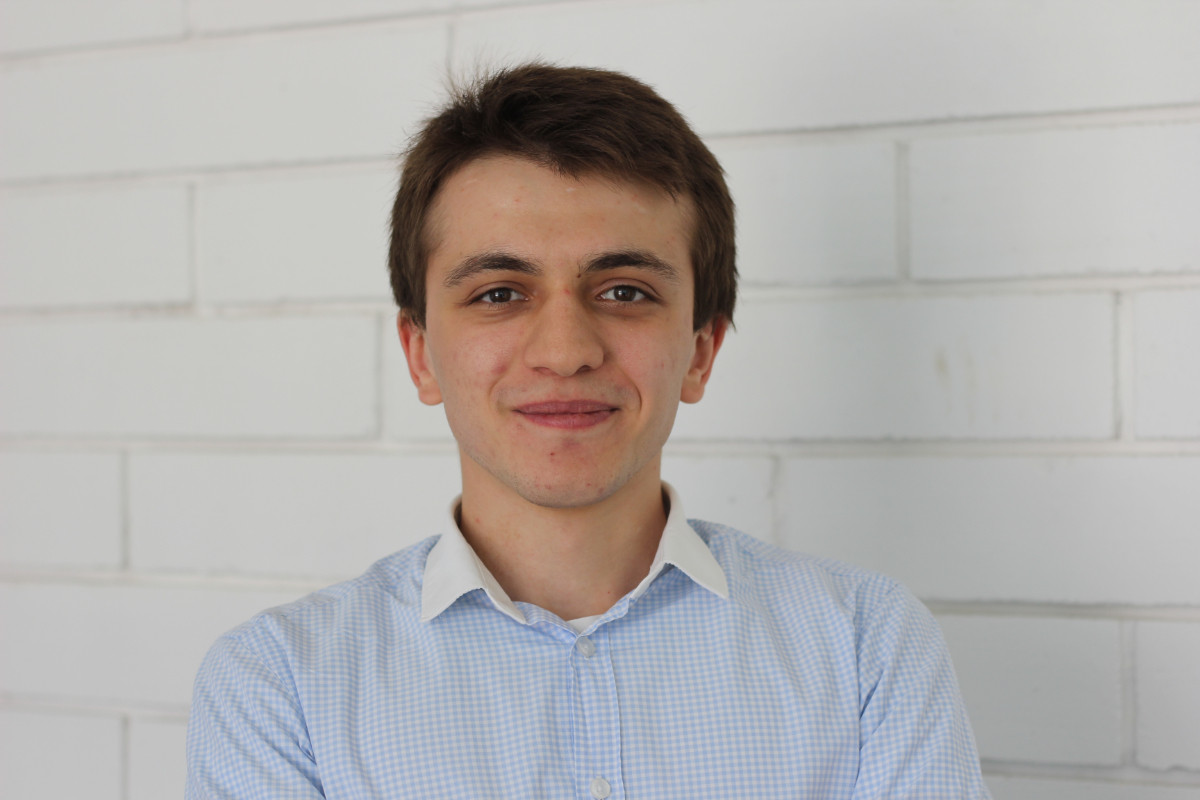
Other team members can be found here.
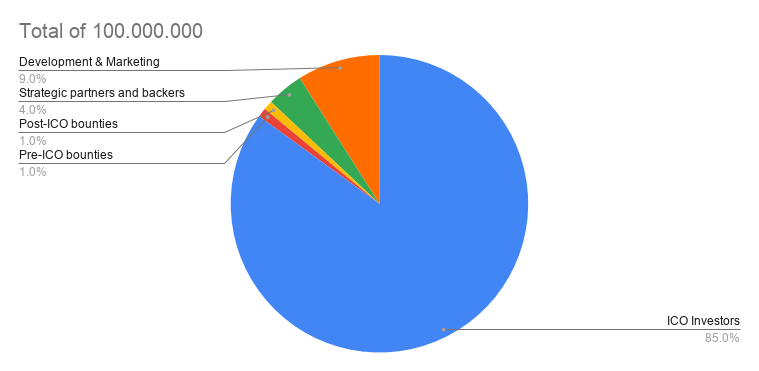
Waves ICO was conducted in the period from April 12, 2016, to May 31, 2016. During the offering, an initial $16,436,095 was raised, selling 85 million WAVES tokens out of the total of 100 million supply that was premined and released in circulation.
As the whole supply of tokens has been emitted from the very start, there isn't any inflation rate, lock-up period (vesting), or creation of more tokens that can severely disturb its economic model.
Rewards gained through mining (nodes validating transactions) were coming from the paid transaction fees on the user's ends and were described in more detail in the previous paragraphs.
Waves started with its main competitive edge, being the fast and easy creation of custom tokens aimed at the ICO market. Since then, we have seen diminishing demand for these types of products, and with the platform still having this functionality, it isn’t brought forward as its main characteristics.
With the new tech developments, especially the Gravity oracle and Neutrino protocol, the Waves is trying to re-establish itself as the market leader in DeFi that enables users to make custom financial products and engage in the decentralized finance space through its native Waves DEX.
While it offers smart contracts and capabilities of building decentralized apps, it isn’t positioned as the Ethereum-like competitor. Still, it is leaning towards being a DeFi platform that competes for the market share of LINK, with its Gravity oracle and stablecoins market with its USDN coin, which can be staked for a high annual yield competing with Aeve, Compound, etc.
With its Smart assets (that can represent tangible real-world assets or ownership rights), it moved away from plain ICOs. It attempted to capture the STO market making its main competitor in this area Polymath.
In summary, as a blockchain smart-contract platform with an ecosystem of protocols and layers of tech, Waves branches out in different niche markets in the cryptocurrency space. Still, although its main competitive advantage is the ease of use and development, its main ambition is to take the DeFi market share, which is currently (while writing this) over 8.5 billion dollar market.
+387
1 hour ago
The biggest social media presence Waves has is on Twitter followed by its sub-reddit. Even though similar announcements are made on both channels Reddit users engage more with the content and are more likely to leave comments and interact with one another. The smallest of them all by the number of followers of their YouTube channel which is reasonable considering that the content they provide isn’t all that suitable for a video format, and is mostly promotional advertisements. They also have a Telegram channel to keep the community updated.
https://waves.tech/waves-protocol
https://www.allcryptowhitepapers.com/waves-whitepaper/
NO INVESTMENT ADVICE
The content is for informational purposes only. You should not construe any such information or other material as legal, tax, investment, financial, or other advice. Nothing contained on our Site constitutes a solicitation, recommendation, endorsement, or offer by Upblock or any third party service provider to buy or sell any cryptocurrencies (also called digital or virtual currencies, crypto assets, altcoins and so on).
DO YOUR OWN RESEARCH
Our content is intended to be used and must be used for informational purposes only. It is essential to do your own analysis before making any investment based on your circumstances. You should take independent financial advice from a professional in connection with or independently research and verify any information that you find on our website and wish to rely upon, whether to make an investment decision or otherwise.